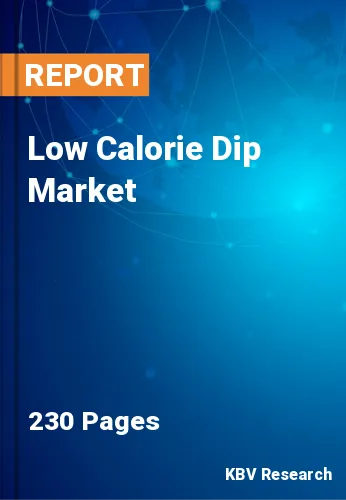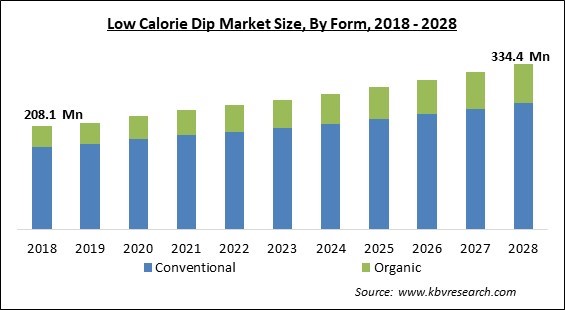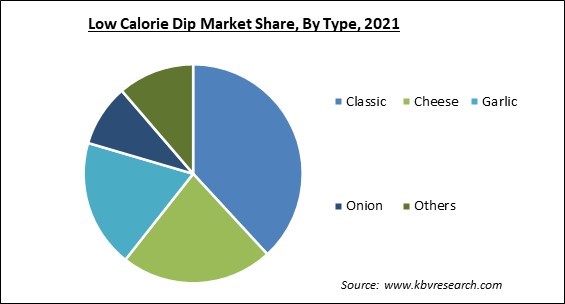
The Global Low Calorie Dip Market size is expected to reach $334.4 million by 2028, rising at a market growth of 4.9% CAGR during the forecast period.
Dips are a popular evening snack, appetizer, and party favorite across all age groups. But most harmful fats come from dips and sauces, including copious amounts of oil. However, one may make their dips low in calories and healthful by substituting curd or vegetable puree for oil in oil-based dips.

Any food that has been altered during preparation to increase its flavor and shelf life is considered processed. There are numerous levels of processing performed on various food varieties. Even while pre-cut green beans and packed salads are technically processed, their original shape has remained the same; hence, the level of processing is modest. In other words, it closely resembles its natural state.
In contrast, a package of macaroni and cheese or a microwaveable meal is regarded to be heavily processed because it contains artificial flavors, additives, and other substances (also known as ultra-processed). Most food consumed by humans has been treated in some form before consumption. However, the controversy around processed foods does not revolve around items such as tuna and tomatoes that have been processed to preserve their freshness and nutritional content.
Organic is one of the most prevalent trends in the food and beverage industry. As customers are becoming more health conscious and aware of the unhealthy development and cultivation of food crops and their impact on the body, the Low-Calorie Dip Market is experiencing an increase due to increasing demand for organic products. Examples of organic product benefits include the absence of toxic chemicals, fertilizers, GMO ingredients, radiation, pesticides, and genetic engineering.
The COVID-19 pandemic had a dual effect on the low-calorie dip industry. This includes offline food establishments, such as restaurants and cafes, which are entirely closed in certain areas, although online meal delivery is available. With the easing of the lockdown and the government's various limitations, the supply chain is expected to return to normal, allowing the production and distribution of different food items, such as dips. Due to these circumstances, the market was initially disrupted, but after a few months of the pandemic, demand increased since customers were increasingly enjoying these items with snacks at home.
This movement toward plant-based diets could be permanent in many countries. In the past few years, many individuals have changed from using the term "vegan" to "plant-based," making this eating more inclusive and accessible to more segments of society. In many locations, it is now possible to find plant-based replacements for beef, eggs, and dairy products (such as cheese, butter, and ice cream) simply by entering a conventional supermarket. Even many restaurants have added or at least added plant-based options to their menus. In addition, plant-based foods taste better than ever, with some being so similar to their animal-based counterparts that it is difficult to detect the difference.
Today, consumers prioritize adopting good eating behaviors to sustain healthy lifestyles. Low-calorie snacks with natural, unprocessed components can provide numerous health benefits without negatively harming the body. Modern consumers are increasingly sensitive to their diets due to their rising holistic perception of their well-being, which encompasses nearly every aspect of healthy living and includes weight management.
The limited availability of the product in emerging economies is one of the reasons restraining the expansion of the low-calorie dip market. A rise in demand for high-calorie foods is a result of customers' evolving taste preferences. In addition, it offers more energy and nutrition than low-calorie snacks. For example, weightlifters may choose high-calorie, nutrient-rich snacks to gain muscle mass. Regular gym-goers can utilize them to increase their stamina. Some individuals may need to become excessively full to ingest enough calories. To gain weight, people must take more calories than they burn daily. Consuming calorie- and nutrient-dense snacks between meals is an excellent method for increasing energy intake without feeling full.
On the basis of form, the low-calorie dip market is divided into organic and conventional. The organic segment acquired a significant revenue share in the low-calorie dip market in 2021. Increasing consumer preference for organic products, which are devoid of toxic chemicals and pesticides, is one of the key growth causes for organic low-calorie dip. In addition, rising consumer concern for environmental sustainability is a significant factor in the uptake of organic products.
Based on the type, the low-calorie dip market is bifurcated into classic, garlic, onion, cheese and others. The classic segment witnessed the largest revenue share in the low-calorie dip market in 2021. This is owing to the fact that consumers prefer traditional dips due to their robust flavours. Guacamole is a thick and creamy avocado-based spread or dip prepared with lime, onion, chili pepper, tomato, garlic, and seasonings such as salt and black pepper.
On the basis of distribution channel, the low-calorie dip classified into hypermarkets & supermarkets, specialty stores, e-commerce and B2B. The e-commerce segment procured a substantial revenue share in the low-calorie dip market in 2021. In recent years, rigorous online marketing has grown the popularity of this distribution channel, which is complimented by vast possibilities, the availability of thorough information, discounts, and free home delivery via various e-commerce platforms.
By end-user, the low-calorie dip market is classified into residential and food services. The food services segment held the highest revenue share in the low-calorie dip market in 2021. Sauces and dressings impart an abundance of taste whether applied to meat, salads, or sandwiches. On the other hand, dips and spreads compete with these more conventional condiments for meals.

| Report Attribute | Details |
|---|---|
| Market size value in 2021 | USD 240.7 Million |
| Market size forecast in 2028 | USD 334.4 Million |
| Base Year | 2021 |
| Historical Period | 2018 to 2020 |
| Forecast Period | 2022 to 2028 |
| Revenue Growth Rate | CAGR of 4.9% from 2022 to 2028 |
| Number of Pages | 230 |
| Number of Tables | 449 |
| Report coverage | Market Trends, Revenue Estimation and Forecast, Segmentation Analysis, Regional and Country Breakdown, Companies Strategic Developments, Company Profiling |
| Segments covered | Form, Type, Distribution Channel, End User, Region |
| Country scope | US, Canada, Mexico, Germany, UK, France, Russia, Spain, Italy, China, Japan, India, South Korea, Singapore, Malaysia, Brazil, Argentina, UAE, Saudi Arabia, South Africa, Nigeria |
| Growth Drivers |
|
| Restraints |
|
Region-wise, the low-calorie dip market is analyzed across North America, Europe, Asia Pacific, and LAMEA. The North America region led the low-calorie dip market by generating the maximum revenue share in the low-calorie dip market in 2021. The market for low calorie dip in North America is driven by an increase in the use of convenience foods, such as dips, and an increase in health and fitness concerns. In addition, North America has a sophisticated retail framework that enables consumers to easily acquire food and consumables. Hence, the easy availability helps with the overall sale of convenience goods such as the low-calorie dip and surge the market’s growth.
Free Valuable Insights: Global Low Calorie Dip Market size to reach USD 334.4 Million by 2028
The market research report covers the analysis of key stake holders of the market. Key companies profiled in the report include PepsiCo, Inc., Nestle S.A., General Mills, Inc., Rigoni Di Asiago S.R.L, Kite Hill, Focus Brands LLC (Roark Capital Group), Good Foods Group, LLC, Earthy Bliss Pvt. Ltd. and The Honest Stand
By Form
By Type
By Distribution Channel
By End User
By Geography
The global Low Calorie Dip Market size is expected to reach $334.4 million by 2028.
Increasing vegan population are driving the market in coming years, however, Low product availability in underdeveloped economies restraints the growth of the market.
PepsiCo, Inc., Nestle S.A., General Mills, Inc., Rigoni Di Asiago S.R.L, Kite Hill, Focus Brands LLC (Roark Capital Group), Good Foods Group, LLC, Earthy Bliss Pvt. Ltd. and The Honest Stand
The B2B market is generating high revenue in the Global Low Calorie Dip Market by Distribution Channel in 2021; thereby, achieving a market value of $148.8 million by 2028.
The Conventional market is leading the segment in the Global Low Calorie Dip Market by Form in 2021; thereby, achieving a market value of $254.8 million by 2028.
The North America market dominated the Global Low Calorie Dip Market by Region in 2021; thereby, achieving a market value of $116 million by 2028.
Our team of dedicated experts can provide you with attractive expansion opportunities for your business.
